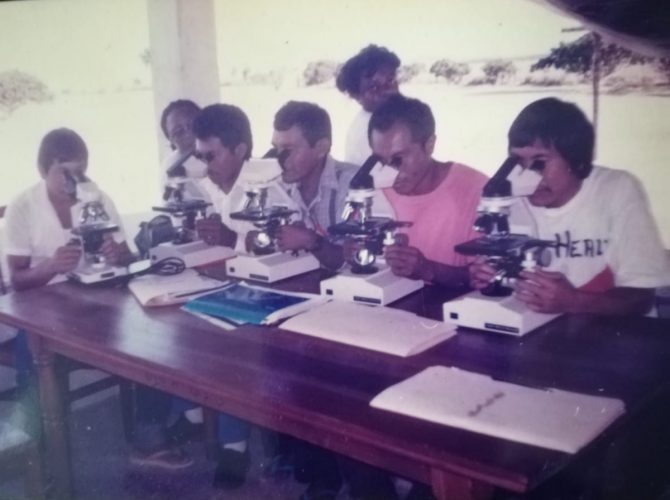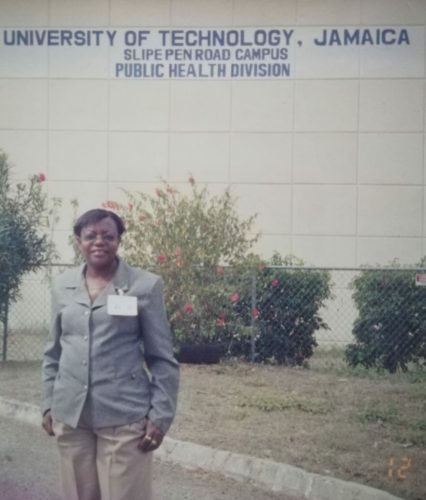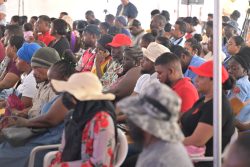As an eight-year-old, Beverly Ann McFarlane killed mosquitos at every opportunity she got, placed them into match boxes, counted and examined them—a harbinger of what lay ahead for the now microscopist.
McFarlane, 67, would eventually be fully engaged in the fight against mosquito-borne diseases and also in sharing her knowledge across the country and in the Caribbean region.
“When my father was building our home in Meadowbrook by self-help, the area was covered in bush. Mosquitos were found in swarms. We were living in East Ruimveldt at the time and my mother would take dinner for him and I would accompany her.”


Since then she saw mosquitoes as destructive.
Born in Albouystown, the sixth of seven children to Doris and Donald Robertson, McFarlane attended the then St Stephen’s Church of Scotland School and later Fraser’s Commercial Institute where she was tutored in shorthand, typewriting and English.
“In those days, lawyers used to request typists and clerks from these institutions of learning and so I started my first job as a typist/clerk for Frank John, a powerful criminal lawyer and then Elvey Overton Edwards, a civil lawyer. I worked with them for several years.”
In 1980, she applied to work in the Ministry of Health’s typing pool. “When I got there, they were short of typewriters. The permanent secretary, Mr. Claude Philadelphia, asked me if I wanted to go into vector control and he explained what it was. I took the opportunity to be trained in this new field.”
As Philadelphia spoke, she remembered officers from the vector control department visiting homes at nights during 1967/1968 due to an outbreak in microfilaria.
They would prick the finger and return to say who were positive and to give treatment at the same time. “As a child, myself and two other siblings were found positive.”
Hearing not only about microfilaria, but malaria, dengue fever, yellow fever and other vector-borne diseases captivated McFarlane’s mind.
Training began on the 27th March 1980 with over 40 recruits from all parts of the country. She learnt that the Culex, the prevalent mosquito of the night, causes microfilaria, the Aedes Egypti that bites during the day causes yellow fever and dengue, and the Anopheles cause the deadly malaria.
“A young man and I topped the class. We were encouraged by other personnel that should there be opening for malaria microscopy, we should seek further training. The word ‘microscopy’ was strange to me. I was never exposed to a microscope, the tool, which would have been so impacting on my life and profession after a while.”
In1980/1981, she took part in the yellow fever inspection team on the coast walking with a yellow flag to do residual spraying using the Hudson pump sprayer with baytex insecticide. The team sprayed garbage bins and tyres, treating larvae and pupa with abate sand granules.
When training was announced to fill vacancies for microscopists, she applied and was successful. Malaria was not prevalent on the coast but was prevalent in the hinterland regions.
The six-week intense training held in 1981, was conducted by personnel from the World Health Organisation and involved the identification of species by density, making accurate diagnosis, treatment and follow up of the epidemiological classification of cases such as where the patient was infected. She was the only female from Georgetown on the course.
“We learnt about indigenous cases, locally imported – meaning it is a parasite from a different region, foreign imported, blood transfusion such as mother to child transfusion, and cryptic classification when it could not be ascertained where the infection took place.
Malaria is spread by the female mosquitos which need human blood to fertilise the eggs. The male mosquitos do not spread malaria. They feed on juices.
Expressing disappointment that no one from in the vector control department visits her area as in the past when they had to take back samples from the field and record their activities and revisit areas to see if people were doing what they were advised to do, she said, “I treat if I see any larvae or pupa or if I see a plant pot catching water, I get rid of the water.”
As Georgetown and the coastal belt had been rid of malaria, McFarlane said, airport vigilance was enforced. “We don’t do that now. We used to do smears at Ogle and Timehri and once found positive we had field staff that treated them at their homes. It was called Direct Observing Treatment or DOT treatment and we did this even before it became a common term used in the treatment of tuberculosis.”
Using the DOT treatment, she said was especially use effective for the plasmodium vivax, which if not treated each day could see the patient suffer a relapse. “If you stop one day of treatment, you had to restart the treatment.”
McFarlane was stationed in the office at Timehri when there were two known species, the plasmodium vivax and plasmodium falciparum, found in Guyana.
Then came plasmodium malariae
“I found the first case of the plasmodium malariae in 1985. We hadn’t much training in this species but I knew the parasite was more stable than vivax. I was going through routine examination and I noted that it was not as active as the Vivax. The formation is also different. I knew I saw something different and I was brave enough to report it as malariae. The person who was doing the epidemiologic investigation found the patient originated from Tanzania, East Africa. His name was Godpen Nyinyi, a name I don’t forget. He was staying in Queenstown opposite Alberttown police station. I used to go and treat him for malaraie until he was tested negative. We use have to do three weeks follow up to check if they were free of the parasite.”
After that case, the influx of Brazilians into Guyana for mining purposes, brought more of the plasmodium malariae into the country, McFarlane noted.
“It is very difficult to get rid, if treatment is not continuous. It can lie dormant for up to 52 years based on cases found,” she said.
For many years the vector control department was on Hadfield Street. Many time patients arrived there almost at death’s door with no doctor to examine and treat them. “Some people would come in a bad state. Some in pyjamas. We had to call an ambulance or find ways to get them to the Georgetown Public Hospital. It was under Dr Noel Blackman that the department was moved in February 1988 to that section of GPHC on Middle Street. Now the department is fully staffed with doctors.”
She recalled a retired army officer who was air-dashed from Kurupung dying at the GPHC from falciparum. He went into the department, did a blood test, rested in one of the couches and died there.
She also recalled the owner of mining company taking a16-year-old for malaria testing even though he was tested negative on all occasions. McFarlane recommended that he be tested for typhoid fever at a private facility where the test was available at the time. He subsequently went into a state of depression, was tested positive for typhoid then died shortly after.
Train the trainers
In 2006, the government recommended McFarlane and another person, Rennie Nazir, to the Pan American Health Organisation (PAHO) to be part of a team to travel to Jamaica where there was an outbreak of malaria after 50 years.
The epidemiological investigations revealed that the malaria was reintroduced into Kingston by Haitians who were coming through the country’s porous border. It was a collaborative effort with health personnel from Cuba, Guyana and Trinidad and Tobago.
“I was responsible for taking samples and teaching the identification of the species. The outbreak was skillfully handled. Luckily it was one species and we had it under control. Nobody died.”
On her return to Guyana, the World Health Organization had recommended training for both private and public health sectors and McFarlane was asked in 2007 to return to conduct some training of the Jamaican health workers in microscopy.
For years, McFarlane travelled to all the hinterland regions to assist in malaria microscopy in areas where there was a high density of the malarial disease. “My first hinterland location was Mabaruma. We worked on a rotational basis. It was also the first time I travelled on a plane.”
She was also required to train and retrain health workers in all aspects of malaria, as well as, quality assurance. However, she worked as a malaria microscopist until retiring in 2010.
She was stationed for months at Mabaruma, Lethem, Mahdia, Kurupung, Kamarang, Arakaka, and Port Kaituma apart from travelling to other hinterland locations, including Moruca and Kato, to conduct training, retraining and quality assurance.
When she started working in malaria microscopy, she said, the majority of cases were in Mazaruni with a concentration in Mahdia, as well as the North West, with Arakaka being one of the nests.
“Mining areas were always a problem so that the department incorporated persons to be trained to take smears, examine slides and diagnose, from the more established mining camps. They sent the slides out to confirm that they were doing the right thing.”
When she was going into the high density areas, she said, she would be told she would contract malaria. “I never had malaria,” she said. In the day time she worked and in the nights she would crawl under a net and sleep.
Occasionally there would be an isolated case found in the city but they were immediately brought under control. She retired in November 2010 after almost 31 years.
“I had a very rewarding career in the public service that landed me a job in a reputable company.”
Eradicating malaria at Guyana Goldfields camps
On retiring from the public service, McFarlane was called for an interview by the then human resources manager and then country manager for an interview for the post of microscopist with the then Guyana Goldfields Inc. They had wanted her to start working immediately but at the time she was on a special assignment contract with PAHO.
Once she completed the assignment she started working with Guyana Goldfields on 2nd December, 2010.
“I went with all my artillery. Fully armed and dangerous with the knowledge accumulated over the years. On my first day working with them at the North Road office, I found a positive vivax case. When I asked what the company did with positive cases, one staffer replied that they never found any positive cases before. From then on I kept finding positives. It was shocking.” The company had previously employed a part-time microscopist.
Having left the GPHC with a good record, she established a network to get her new patients treated. She double checked for quality assurance.
“Because the bulk of employees in those days travelled through Parika via Buck Hall, I used a shack to take the smears and do the testing two days a week. I never allowed them to travel until the results were out. There and then I recognized the magnitude of the cases coming from Moruca. A lot of workers, who were cutting lines, came from there. That was in early 2011. We never spared the expats. Everyone was subject to being tested.”
Depending on the species, the incubation period for falciparum is seven days and for vivax, 10 days.
“I started this rigid exercise where no one could leave Georgetown without a test. I had to deal with the set going in by road and by air. At one stage, a few cases made me go to Aurora. They had a nest on a hill where there was a set of tyres. We treated and got rid of the tyres. We maintained constant surveillance at Sulphur Rose, Tapir and Buck Hall. That was how I could safely say we eradicated malaria from every area. If you had malaria, you had to show two negative rejects to return.”
For nine years, she said, “I worked alone in microscopy with Guyana Goldfields. I recorded, took smears, stained the slides, examined them and gave correct diagnosis. If were at the GPHC, that work would have required four people. One to record, one to take the smear, one to stain the slides, and one to examine and diagnose.”
In 2014, she received the country manager’s award recognizing her work for over and beyond the call of duty. She has also received several meritorious awards from the Ministry of Health.








